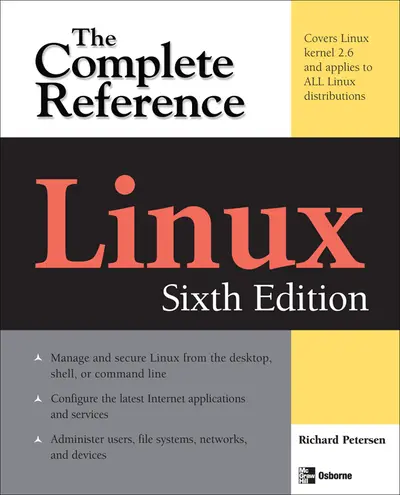My Account Details

ISBN10: 007149247X | ISBN13: 9780071492478

Step 1 . Download Adobe Digital Editions to your PC or Mac desktop/laptop.
Step 2. Register and authorize your Adobe ID (optional). To access your eBook on multiple devices, first create an Adobe ID at account.adobe.com. Then, open Adobe Digital Editions, go to the Help menu, and select "Authorize Computer" to link your Adobe ID.
Step 3. Open Your eBook. Use Adobe Digital Editions to open the file. If the eBook doesn’t open, contact customer service for assistance.
Publisher's Note: Products purchased from Third Party sellers are not guaranteed by the publisher for quality, authenticity, or access to any online entitlements included with the product. Your one-stop guide to Linux--fully revised and expanded Get in-depth coverage of all Linux features, tools, and utilities from this thoroughly updated and comprehensive resource, designed for all Linux distributions. Written by Linux expert Richard Petersen, this book explains how to get up-and-running on Linux, use the desktops and shells, manage applications, deploy servers, implement security measures, and handle system and network administration tasks. With full coverage of the latest platform, Linux: The Complete Reference, Sixth Edition includes details on the very different and popular Debian (Ubuntu) and Red Hat/Fedora software installation and service management tools used by most distributions. This is a must-have guide for all Linux users. Install, configure, and administer any Linux distribution Work with files and folders from the BASH, TCSH, and Z shells Use the GNOME and KDE desktops, X Windows, and display managers Set up office, database, Internet, and multimedia applications Secure data using SELinux, netfilter, SSH, and Kerberos Encrypt network transmissions with GPG, LUKS, and IPsec Deploy FTP, Web, mail, proxy, print, news, and database servers Administer system resources using HAL, udev, and virtualization (KVM and Xen) Configure and maintain IPv6, DHCPv6, NIS, networking, and remote access Access remote files and devices using NFSv4, GFS, PVFS, NIS, and SAMBA
Chapter 1. Introduction to Linux
Chapter 2. Getting Started
Part II: The Linux Shell and File Structure
Chapter 3. The Shell
Chapter 4. The Shell Scripts and Programming
Chapter 5. Shell Configuration
Chapter 6. Linux Files, Directories, and Archives
Part III: Desktop
Chapter 7. The X Window System, Xorg, and Display Managers
Chapter 8. GNOME
Chapter 9. KDE
Part IV: Linux Software
Chapter 10. Software Management
Chapter 11. Office and Database Applications
Chapter 12. Graphics Tools and Multimedia
Chapter 13. Mail and News Clients
Chapter 14. Web, FTP, and Java Clients
Chapter 15. Network Tools
Part V: Security
Chapter 16. Encryption, Integrity Checks, and Signatures
Chapter 17. Security-Enhanced Linux
Chapter 18. IPsec and Virtual Private Networks
Chapter 19. Secure Shell and Kerberos
Chapter 20. Firewalls
Part VI: Internet and Network Services
Chapter 21. Managing Services
Chapter 22. FTP Servers
Chapter 23. Web Servers
Chapter 24. Proxy Servers
Chapter 25. Mail Servers
Chapter 26. Print, News, Search, and Database Servers
Part VII: System Administration
Chapter 27. Basic System Administration
Chapter 28. Managing Users
Chapter 29. File Systems
Chapter 30. RAID and LVM
Chapter 31. Devices and Modules
Chapter 32. Kernel Administration
Chapter 33. Backup Management
Part VIII: Network Administration Services
Chapter 34. Administering TCP/IP Networks
Chapter 35. Network Autoconfiguration with IPv6, DHCPv6, and DHCP
Chapter 36. NFS and NIS
Chapter 37. Distributed Network File Systems
Appendix A: Where to Obtain Linux Distribution
Index
Need support? We're here to help - Get real-world support and resources every step of the way.